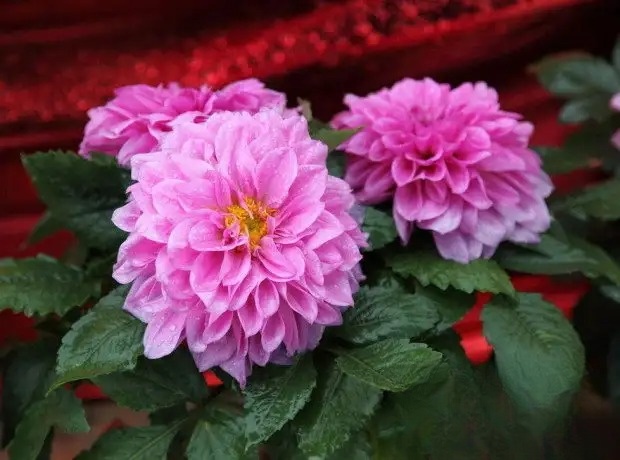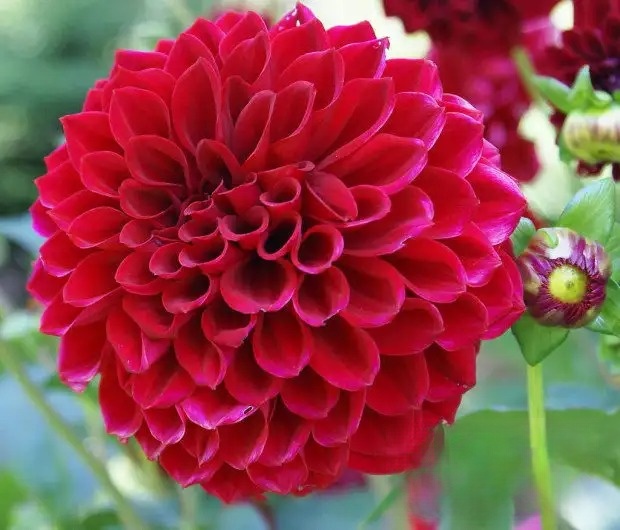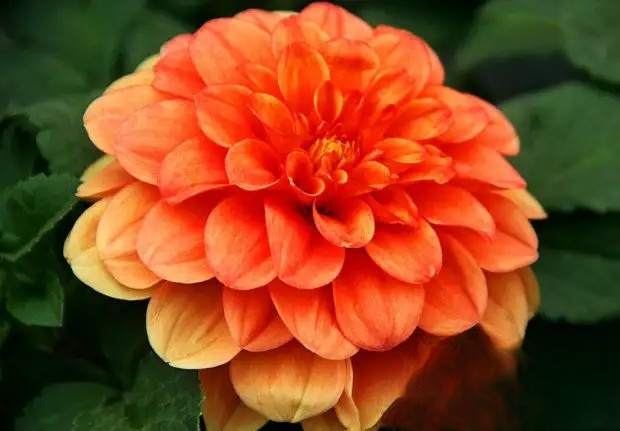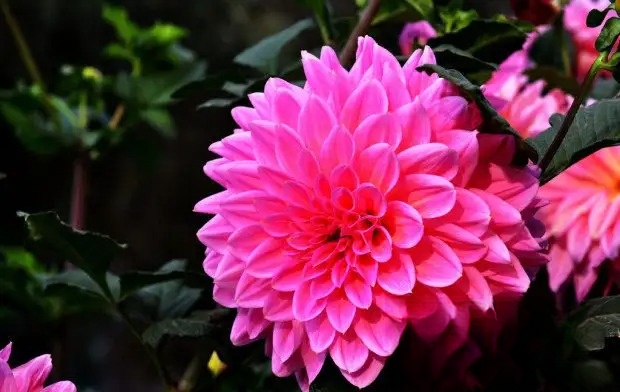Cultivation and breeding methods of dahlia

Dahlia
The root of dahlia is shaped like sweet potato, commonly known as sweet potato flower or sweet potato chrysanthemum. It is named passion flower because it comes from overseas and its petals are broad and thick like lotus. The flowering period is long, from summer to autumn, and it is continuous. The flowers are gorgeous, dazzling, and have various postures. It is one of the world's famous flowers.
There are many varieties of dahlias, with great variations in plant height, flower shape, color, and petals. The most cultivated dahlias are in Jilin City, and the famous varieties include Huaqing Palace, Universe, Ancient Golden Palace, Xishi, and Red Velvet. Its underground tubers can survive the winter if the soil is not frozen, and new buds will sprout from the root neck in the next spring, and it will grow and bloom again. Therefore, it is a perennial root flower . Whether it is used as a potted plant for viewing, as a cut flower in a vase, or planted in the courtyard, dahlias are very suitable.
Dahlias are native to Mexico. They like sunshine and a well-ventilated environment. The best exposure time is 10-12 hours a day. They are not very demanding on temperature during their growth period. They can adapt to temperatures between 5 and 35 degrees, and 10-25 degrees is the most suitable. They are not cold-resistant and do not like hot summers. They like cool climates during their flowering period, but once they are hit by frost, their stems, leaves, and flowers will wither. They require a period of low temperature every year to satisfy their dormancy. They are not drought-resistant and afraid of waterlogging. The south is hot and rainy in summer, so dahlias do not grow as well as in the north. The soil should be sandy loam rich in humus and well-drained.
There are three main methods of dahlia propagation : sowing , dividing tubers and cutting. The sowing method is mainly used for single-petal varieties (or when cultivating new varieties , single-petal varieties are used for easy seed collection. The seeds are sown in spring. The temperature requirement for sowing is 15-20 degrees during the day and 12-18 degrees at night. Some varieties can bloom only 3 months after sowing. For varieties that need to be sown and propagated, attention should be paid to auxiliary pollination after the cool autumn so that the seeds can develop fully. The pollinated flowers have about 25-30 seeds.
It matures in 20 days, and there is great variability in seed reproduction ; but the seedlings grow vigorously.
The root division method is to take out the dahlia root stored in the previous year, plant it in loose potting soil, and place it in the conditions of 18-20 degrees during the day and 15-20 degrees at night to germinate. After the new buds sprout, take out the original tubers, remove the potting soil, and then cut them from the root neck with a knife, leaving 1-2 buds on each plant, smear the incision with plant ash, and then plant them in flower pots to cultivate them into independent plants. However, the growth potential is not as vigorous as that of cuttings .
The most common propagation method is cutting. When the buds growing out of the old mound are 6-10 cm long, they are cut with a blade and inserted into the sand in the shade of the flowers. The temperature requirement is to maintain it at 20-22 degrees during the day and 15-18 degrees at night. It varies depending on the variety. It will take 10-20 days to grow. After the buds grow, they are potted and gradually moved to a sunny place. As the seedlings grow, they are gradually replaced with larger pots. The most suitable soil for home potting is a mixture of 5 parts of leaf mold, 3 parts of sand and 2 parts of furnace ash. This soil is rich in nutrients, well-drained, not hardened, and conducive to rooting. The bottom of the pot must have a large drainage hole. When potting, use tiles and coarse sand and gravel to pad the drainage layer. For flower seedlings planted in rain-proof and waterlogging-proof areas, choose a location with higher terrain and good drainage to prevent rain and waterlogging from causing root rot and plant death.
Generally, seedlings need to be repotted four or five times before flowering. The pot should be changed every time the new white tender roots grow to half of the soil ball. If the fibrous roots are fully grown before repotting, the growth of dahlias will be affected. When repotting, the "shoulder soil" (the soil on the edge of the pot surface) can be appropriately removed, and attention should be paid to keeping the soil ball together. Increasing the number of repotting can properly control the height of the plant, prolong the flowering period, make the stem thicker and the flower larger. For the last planting pot, 5-6 pieces of horseshoe slices or sheep's hoof shells should be placed on the drainage layer at the bottom of the pot to supplement the base fertilizer. The pot diameter can be 25-30 cm.
When the planted seedlings grow to 30 cm in height, start pruning. If you want to cultivate a single plant, you should cut off all the side buds and leave only the main branch; if you want to enjoy multiple flower heads, you should first cut off 2-3 pairs of side buds below the top of the main branch, and then keep the lower side branches as planned; the buds of dahlias are usually one main bud and two side buds growing together on the branch tips. You can remove two of them in the process of growth, and choose the best one to keep and let it grow and bloom; in order to properly adjust the flowering period, you can also use the method of fixed buds, that is, the buds with a diameter of about 1 cm will take about 25 days to bloom.
After the first flowering of potted dahlias, you can do renewal pruning. That is, cut off 4-5 cm from the base of the plant, then water it thoroughly, and then use soil to cultivate the remaining short stems and roots. The center height of the cultivated soil is just level with the top of the retained stems. Soon new buds will grow from the base. Prune the branches according to the above method, and cultivate them for two months to be full of flowers. Generally, renewal pruning is done after the first flowering in early July, and it will bloom again by National Day.
When watering dahlias, you must follow the principle of "water thoroughly when the soil is dry". After watering thoroughly, wait until the leaves begin to droop before watering again. If it is going to rain, even if the soil in the pot is a little dry, you don't need to water it. Don't water the seedlings too much to prevent them from growing too tall. In the rainy season, you should add some fertile soil, mainly leaf humus, to the pots that are too deep at the edges to prevent water accumulation in the pots. It should also be noted that after a series of cloudy days, sunny days will appear, because the leaves cannot withstand the sudden exposure to the sun and will wilt, but the actual soil in the pot is not dry. Therefore, when the sky is clear after the rain and the heat is high, you can sprinkle water on the ground to cool it down. In midsummer, water evaporates quickly and quickly, so you can spray water two or three times a day to replenish the lack of water.
Dahlias like fertilizer, but it is not suitable to fertilize when the temperature is high. After the beginning of autumn, fertilizer can be applied once a week, and stop fertilizing and watering when the flower buds are translucent. If fertilizer is interrupted, the stems will appear uneven in thickness, or thick at the bottom and thin at the top, and good flowers will not bloom. Therefore, the amount of fertilizer should be determined according to the growth of the plant. If the leaves are light in color and thin in texture, it is a lack of fertilizer; on the contrary, if the fertilizer is excessive, the edges of the leaves will be burnt or the tips of the leaves will be yellow; if the leaves are thick and the color is dark green, it is a sign of appropriate fertilization. The concentration of fertilizer should be increased each time, so that the stems grow thicker and stronger as they grow upwards. At the same time, fertilizer and water must be properly matched. If there is too much fertilizer and too little water, the leaves will shrink and not stretch.
After the roots of the potted dahlias placed in the courtyard have grown full of soil, they can penetrate into the ground through the holes at the bottom of the pot. It is then not advisable to move the pots again, which is conducive to the growth of the plants in the rainy season and prevents them from being affected by waterlogging.
The stems of dahlias are hollow and brittle. To prevent them from being blown down or broken by the wind, or from growing crooked, high-quality varieties should be supported by thin bamboo poles when they grow to 30 cm. The poles should be inserted into the soil near the base of the stems, and the stems should be tied to the bamboo poles with thin ropes. As the plants grow, the poles should be replaced, and the top of the poles should be close to the bottom of the flower buds for the last time.
In summer, use a homemade wire rake to loosen the potting soil two or three times to make the topsoil loose and breathable, remove weeds, reduce water and nutrient consumption, and ensure good plant growth.
If dahlia seedlings are planted in the courtyard, they will grow stronger and more luxuriantly than potted plants, with more flowers, a longer flowering period, and much easier to manage than potted plants. Dahlia tubers cannot spend the winter in the courtyard in North China. When the leaves of the above-ground part of the plant fall off after frost, the old stems with a length of 10 cm above the root neck should be cut off, the tubers should be dug out, and dried for two days. Frost should be prevented at night, and they can be buried in slightly moist sandy soil in a dark place with a temperature not exceeding 5 degrees. During winter storage, they should be checked frequently. If the buried sand is found to be too dry, do not water directly. The sand and tubers can be separated, and the sand can be slightly sprinkled with water and stirred evenly to make the buried sand moist, and then the tubers should be buried. When checking, rotten and useless roots should be cut off.
The most likely pests and diseases to occur in dahlia cultivation are: red spider mites and aphids, which are mainly caused by dry weather, poor ventilation or high temperature. Spraying should be carried out in time to prevent and control them, and ventilation should be strengthened, water should be sprinkled on the ground to cool down, and cultivation conditions should be improved. In addition, when changing pots, sometimes white and yellow fat silkworms are found in the pot soil. Silkworms mainly harm tuberous roots, which hinder the growth of plants and can seriously cause the death of the whole plant. The main preventive measure is to use fully decomposed leaf humus. When insects are found to harm, 1000 times 90% of trichlorfon can be used for root irrigation. One of the key issues for the success or failure of cultivating dahlias should also be noted to prevent the larvae of the borer from drilling into the stems in June to kill the plants. Generally, spraying insecticide I every 20 days or so from June to September can prevent the larvae of the borer from drilling in. When powdery mildew occurs, spray 1000 times of carbendazim with water in time to prevent and control, which can stop the spread of white powdery spots on the back of the leaves.
The root tubers of dahlia contain inulin, which has the same medical effects as glucose .

Dahlia

Dahlia

Dahlia